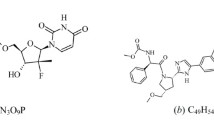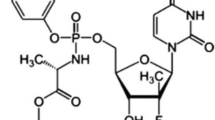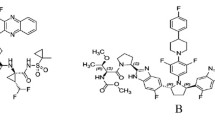Abstract
A simple and sensitive stability indicating high performance liquid chromatography method was developed for quantification of Daclatasvir hydrochloride in bulk and tablet dosage forms. The analysis was performed on water symmetry analytical column (150 mm × 3.9 mm, 5 µm), packing octyl silica (Si-[CH2]7-CH3) C8. Mobile phase containing potassium phosphate buffer (pH 2.0) and acetonitrile (38: 62) v/v was used at flow rate 0.7 mL min−1 for isocratic elution. Detection was performed on 304 nm using UV detector. The method was validated appropriately according to the requirements of United State Pharmacopeia and International Conference on Harmonization guideline Q2 (R1). Recovery, precision, linearity and specificity of the method were assured. The correlation coefficient for linearity ranged from 2 to 24 µg mL−1 was (r > 0.9999). The limits of detection and quantification of Daclatasvir were 0.08 and 0.28 µg mL−1, respectively. Stability studies of Daclatasvir were performed under various stressed conditions, i.e., hydrolytic (acidic, basic and neutral), oxidation, photolytic and thermal conditions, according to International Conference on Harmonization Q1A (R2) and QIB Guidelines. The degradation products were resolved using proposed method and further characterized by MS, NMR and IR spectroscopic analyses. The proposed method was successfully applied to assay determination of bulk drugs and tablet dosage forms.







Similar content being viewed by others
References
Shepard CW, Finelli L, Alter MJ (2005) Global epidemiology of hepatitis C virus infection. Lancet Infect Dis 5:558–567
Lavanchy D (2011) Evolving epidemiology of hepatitis C virus. Clin Microbiol Infect 17:107–115
Maasoumy B, Wedemeyer H (2012) Natural history of acute and chronic hepatitis C. Best Pract Res Clin Gastroenterol 26:401–412
Terrault N (2012) Liver transplantation in the setting of chronic HCV. Best Pract Res Clin Gastroenterol 26:531–548
Ghany MG, Nelson DR, Strader DB, Thomas DL, Seeff LB (2011) An update on treatment of genotype 1 chronic hepatitis C virus infection: 2011 practice guideline by the American association for the study of liver diseases. Hepatology 54:1433–1444
Magiorkinis G, Sypsa V, Magiorkinis E, Paraskevis D, Katsoulidou A, Belshaw R et al (2013) Integrating phylodynamics and epidemiology to estimate transmission diversity in viral epidemics. PLoS Comput Biol 9:e1002876
Naggie S, Patel K, McHutchison J (2010) Hepatitis C virus directly acting antivirals: current developments with NS3/4A HCV serine protease inhibitors. J Antimicrob Chemother 65:2063–2069
Jacobson IM, McHutchison JG, Dusheiko G, Di Bisceglie AM, Reddy KR, Bzowej NH et al (2011) Telaprevir for previously untreated chronic hepatitis C virus infection. N Engl J Med 364:2405–2416
Poordad F, McCone J Jr, Bacon BR, Bruno S, Manns MP, Sulkowski MS et al (2011) Boceprevir for untreated chronic HCV genotype 1 infection. N Engl J Med 364:1195–1206
McPhee F, Sheaffer AK, Friborg J, Hernandez D, Falk P, Zhai G et al (2012) Preclinical profile and characterization of the hepatitis C virus NS3 protease inhibitor asunaprevir (BMS-650032). Antimicrob Agents Chemother 56:5387–5396
Lemm JA, Liu M, Gentles RG, Ding M, Voss S, Pelosi LA et al (2014) Preclinical characterization of BMS-791325, an allosteric inhibitor of hepatitis C virus NS5B polymerase. Antimicrob Agents Chemother 58:3485–3495
Rose L, Bias TE, Mathias CB, Trooskin SB, Fong JJ (2014) Sofosbuvir: a nucleotide NS5B inhibitor for the treatment of chronic hepatitis C infection. Ann Pharmacother 48:1019–1029
Afdhal N, Zeuzem S, Kwo P, Chojkier M, Gitlin N, Puoti M et al (2014) Ledipasvir and sofosbuvir for untreated HCV genotype 1 infection. N Engl J Med 370:1889–1898
Smith MA, Regal RE, Mohammad RA (2016) Daclatasvir: a NS5A replication complex inhibitor for hepatitis C infection. Ann Pharmacother 50:39–46
Fridell RA, Wang C, Sun JH, O’boyle DR, Nower P, Valera L et al (2011) Genotypic and phenotypic analysis of variants resistant to hepatitis C virus nonstructural protein 5A replication complex inhibitor BMS-790052 in humans. In vitro and in vivo correlations. Hepatology 54:1924–1935
Burgess S, Partovi N, Yoshida EM, Erb SR, Azalgara VM, Hussaini T (2015) Drug interactions with direct-acting antivirals for hepatitis C: implications for HIV and transplant patients. Ann Pharmacother 49:674–687
Bifano M, Hwang C, Oosterhuis B, Hartstra J, Grasela D, Tiessen R et al (2013) Assessment of pharmacokinetic interactions of the HCV NS5A replication complex inhibitor daclatasvir with antiretroviral agents: ritonavir-boosted atazanavir, efavirenz and tenofovir. Antivir Ther 18:931–940
Assessment Report EMEA/H/C/003768/0000 (2014) Committee for medicinal products for human use (CHMP) (http://www.ema.europa.eu/docs/enGB/documentlibrary/EPAR-Publicassessmentreport/human/003768/WC500172849.pdf. Accessed Nov 2016
Yuan L, Jiang H, Ouyang Z, Xia Y-Q, Zeng J, Peng Q et al (2013) A rugged and accurate liquid chromatography–tandem mass spectrometry method for the determination of asunaprevir, an NS3 protease inhibitor, in plasma. J Chromatogr B 921:81–86
Jiang H, Zeng J, Kandoussi H, Liu Y, Wang X, Bifano M et al (2012) A sensitive and accurate liquid chromatography–tandem mass spectrometry method for quantitative determination of the novel hepatitis C NS5A inhibitor BMS-790052 (daclastasvir) in human plasma and urine. J Chromatogr A 1245:117–121
Jiang H, Kandoussi H, Zeng J, Wang J, Demers R, Eley T et al (2015) Multiplexed LC-MS/MS method for the simultaneous quantitation of three novel hepatitis C antivirals, daclatasvir, asunaprevir, and beclabuvir in human plasma. J Pharm Biomed Anal 107:409–418
Ariaudo A, Favata F, De Nicolò A, Simiele M, Paglietti L, Boglione L et al (2016) A UHPLC–MS/MS method for the quantification of direct antiviral agents simeprevir, daclatasvir, ledipasvir, sofosbuvir/GS-331007, dasabuvir, ombitasvir and paritaprevir, together with ritonavir, in human plasma. J Pharm Biomed Anal 125:369–375
Rezk MR, Bendas ER, Basalious EB, Karim IA (2016) Development and validation of sensitive and rapid UPLC–MS/MS method for quantitative determination of daclatasvir in human plasma: application to a bioequivalence study. J Pharm Biomed Anal 128:61–66
Nannetti G, Messa L, Celegato M, Pagni S, Basso M, Parisi SG et al (2017) Development and validation of a simple and robust HPLC method with UV detection for quantification of the hepatitis C virus inhibitor daclatasvir in human plasma. J Pharm Biomed Anal 134:275–281
Srinivasu G, Kumar KN, Thirupathi C, Narayana CL, Murthy CP (2016) Development and validation of the chiral HPLC method for daclatasvir in gradient elution mode on amylose-based immobilized chiral stationary phase. Chromatographia 79:1457–1467
Chakravarthy VA, Sailaja B (2016) Method development and validation of assay and dissolution methods for the estimation of daclatasvir in tablet dosage forms by reverse phase HPLC. Eur J Pharm Med Res 3:356–364
Saleh H, Ragab GH, Othman MA (2016) Stability indicating HPLC method development and validation for determination of daclatasvir in pure and tablets dosage forms. Indo Am J Pharm Sci 3(12):1565–1572
Baker M, El-Kafrawy D, Mahrous M, Belal T (2017) Validated stability-indicating HPLC-DAD method for determination of the recently approved hepatitis C antiviral agent daclatasvir. Ann Pharm Fr 75(3):176–184
Hassib ST, Taha EA, Elkady EF, Barakat GH (2017) Reversed-phase liquid chromatographic method for determination of daclatasvir dihydrochloride and study of its degradation behavior. Chromatographia 80(7):1101–1107
ICH (2003) ICH harmonised tripartite guideline Q1A(R2): Stability testing of new drug substances and products. ICH, Geneva. https://www.ich.org/fileadmin/Public_Web_Site/ICH_Products/Guidelines/Quality/Q1A_R2/Step4/Q1A_R2__Guideline.pdf. Accessed Nov 2016
ICH (1996) ICH harmonised tripartite guideline Q1B: photo stability testing of new drug substances and products, ICH, Geneva. https://www.ich.org/fileadmin/Public_Web_Site/ICHProducts/Guidelines/Quality/Q1B/Step4/Q1B_Guideline.pdf Accessed Nov 2016
USP (2014) The United States Pharmacopeia, 37th revision. United States Pharmacopeial Convention, Rockville, pp 1157–1162
ICH (2005) ICH harmonised tripartite guideline Q2(R1): validation of analytical procedures. ICH, Geneva. http://www.ich.org/fileadmin/Public_Web_Site/ICH_Products/Guidelines/Quality/Q2_R1/Step4/Q2_R1__Guideline.pdf. Accessed Nov 2016
Acknowledgments
The authors are thankful to Genome Pharmaceuticals for providing generic products, reference standards and for their support in this work.
Author information
Authors and Affiliations
Corresponding author
Ethics declarations
Conflict of interest
The authors declare no conflict of interest.
Ethical approval
This article does not contain any studies with human participants or animals performed by any of the authors.
Electronic supplementary material
Below is the link to the electronic supplementary material.
Rights and permissions
About this article
Cite this article
Zaman, B., Hassan, W. Development of Stability Indicating HPLC–UV Method for Determination of Daclatasvir and Characterization of Forced Degradation Products. Chromatographia 81, 785–797 (2018). https://doi.org/10.1007/s10337-018-3503-7
Received:
Revised:
Accepted:
Published:
Issue Date:
DOI: https://doi.org/10.1007/s10337-018-3503-7




